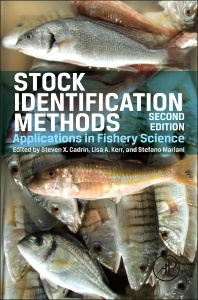Stock Identification Methods (2nd Ed.) Applications in Fishery Science
Coordonnateurs : Cadrin Steven X., Kerr Lisa A., Mariani Stefano

Stock Identification Methods, 2e, continues to provide a comprehensive review of the various disciplines used to study the population structure of fishery resources. It represents the worldwide experience and perspectives of experts on each method, assembled through a working group of the International Council for the Exploration of the Sea. The book is organized to foster interdisciplinary analyses and conclusions about stock structure, a crucial topic for fishery science and management.
Technological advances have promoted the development of stock identification methods in many directions, resulting in a confusing variety of approaches. Based on central tenets of population biology and management needs, this valuable resource offers a unified framework for understanding stock structure by promoting an understanding of the relative merits and sensitivities of each approach.
Foreword Introduction
1. Stock Identification Methods: An Overview
2. The Unit Stock Concept: Bounded Fish and Fisheries
3. Fishery Management Strategies for Addressing Complex Spatial Structure in Marine Fish Stocks
Geographic Variation
Life History Traits
4. Quantitative Traits
5. The continuing role of life history parameters to identify stock structure
Morphology
6. Morphometric Landmarks
7. Morphometric Outlines
8. Analysis of growth marks in calcified structures: insights into stock structure and migration pathways
9. Meristics
Environmental Signals
10. Parasites as Biological Tags
11. Chemical Composition of Fish Hard Parts as a Natural Marker of Fish Stocks
12. Fatty Acid Profiles as Natural Marks for Stock Identification
Genetic Analyses
13. Application of Mitochondrial DNA in Stock Identification
14. The Nuclear Genome: Neutral and Adaptive Markers in Fisheries Science
Movement and Mixing
15. The use of early life stages in stock identification studies
16. Conventional and Radio Frequency Identification (RFID) tags
17. Acoustic and Radio Telemetry
18. Estimation of Movement from Tagging Data
19. Telemetry Analysis of Highly Migratory Species
Interdisciplinary Analyses
20. Sampling for Interdisiplinary Analysis
21. Simulation Modeling as a Tool for Synthesis of Stock Identification Information
22. Interdisciplinary Evaluation of Spatial Population Structure for Definition of Fishery Management Units
- Describes 18 distinct approaches to stock identification grouped into sections on life history traits, environmental signals, genetic analyses, and applied marks
- Features experts' reviews of benchmark case studies, general protocols, and the strengths and weaknesses of each identification method
- Reviews statistical techniques for exploring stock patterns, testing for differences among putative stocks, stock discrimination, and stock composition analysis
- Focuses on the challenges of interpreting data and managing mixed-stock fisheries
Date de parution : 12-2013
Ouvrage de 588 p.
15x22.8 cm
Épuisé
Thème de Stock Identification Methods :
Mots-clés :
Abundance; Acoustic telemetry; Adaptation; Age; Atlantic and coho salmon; Atlantic herring; Behavior; Chemical composition; Connectivity; Conservation; Contingent; Contingents; Discriminant functions analysis; Distribution; Effect size; Effective population size; Egg size; Environmental; Exploratory data analysis; External tags; Fecundity; Fin rays; Fin spines; Fish migration; Fish tagging; Fisheries management; Fishery management; Gene flow; Genetic drift; Genomics; Geolocation; Growth; Growth analysis; Harvest control rule; Home range; Homing; Life cycle; Logistic regression; Management area; Management strategy evaluation; Marine protected area; Matched sampling; Maturity; Meristic; Metapopulation; Microsatellites; Migration; Migration pathways; Mitochondrial DNA; Mixed stock; Morphometric landmarks; Mortality; Movement; Movement rate assessment; Movement studies; Multidisciplinary analysis; Natal homing; Nested governance; Observational studies; Otolith; Otoliths; Phenotypic plasticity; Phenotypic stock identification; Population; Population genetics; Practical management unit; Principal components analysis; Radio telemetry; Reaction norm; Recruitment; Reproduction; RFID/PIT tags; Sampling; Sampling design; Sampling logistics; Scale; Scale dependence; Scales; Seascape genetics; Shifted stock; Simulation model; Site fidelity; Size; SNPs; Spatial indices; Spatially explicit models; Spawning; Species identification; State space models; Statistical analysis; Statistical power; Stock assessment; Stock discrimination; Stock identification; Stock identity; Stock structure; Striped bass; Tagging procedures; Temporal stability; Unit stock; Vertebrae; Winter flounder



